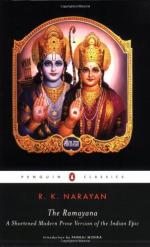|
This section contains 11,194 words (approx. 38 pages at 300 words per page) |

|
SOURCE: Rao, Velcheru Narayana. “The Politics of Telugu Ramayanas: Colonialism, Print Culture, and Literary Movements.” In Questioning Ramayanas: A South Asian Tradition, edited by Paula Richman, pp. 159-85. Berkeley: University of California Press, 2001.
In the following essay, Rao reviews a variety of political and ideological criticism, rewritings and readings of the Ramayana.
When the play Śambuka Vadha (Shambuka Murdered) was published in 1920, it caused a considerable stir.1 The play is based on a story from the Ramayana but was presented in a manner that repelled its readers, who had been used to reading devotional stories of Rama. The author of the play, Tripuraneni Ramasvami Chaudari (1887-1943), whom I will introduce more fully later, depicts the killing of the Dravidian Shambuka as a murder committed by the Aryan Kshatriya king Rama at the behest of his Aryan Brahmin advisers. All traditional readers of the Ramayana in Telugu know that...
|
This section contains 11,194 words (approx. 38 pages at 300 words per page) |

|


